|
The ad. above for the Glasgow Wireless College at Charing Cross appeared in
the Hillhead High School magazine in 1953. At age 11 it didn't attract my attention at the time !
A rather delapidated Yorkhill Quay
below. A favourite 'hang-out' of mine plus bike and camera in the fifties.
The once proud domain of Anchor Line. The house
flag may still be seen in the circular indent on the warehouse wall. Picture taken in the 70s. In 2008 this shed has
been totally removed..............apart for a pathetic so-called Maritime Museum close by (for such a once busy and industrious
port for both cargo handling and shipbulding the City Fathers could surely have settled for a more fitting monument) all evidence
of the busy port has gone. The excellent Transport Museum is, however, not far away ! Many of the ships built
on the Clyde are there. These models once graced the board rooms of the many British shipping companies.
The picture below is of an HF operating
position at Burnham Radio GKL in the early sixties. Terry Gardner and the author worked there together between '67 and '69
and spent many happy, albeit frustrating times. Any readers familiar with the working conditions about this time will appreciate
the 'frustrating' aspect! The somewhat sub-standard inland communication facilities then meant that it often took longer to
forward a message to a ships head office in London than it took to receive the message from the other side of the world. That
being said Portisheadradio was a very efficient station and a major boon to shipowners who got away with very inexpensive
service when compared with today.
|
|
| Radio Officer Doug Howick aboard PORT FAIRY 1957 |
|
|
| Radio Officer Don Chapman aboard CHUSAN 1960 |
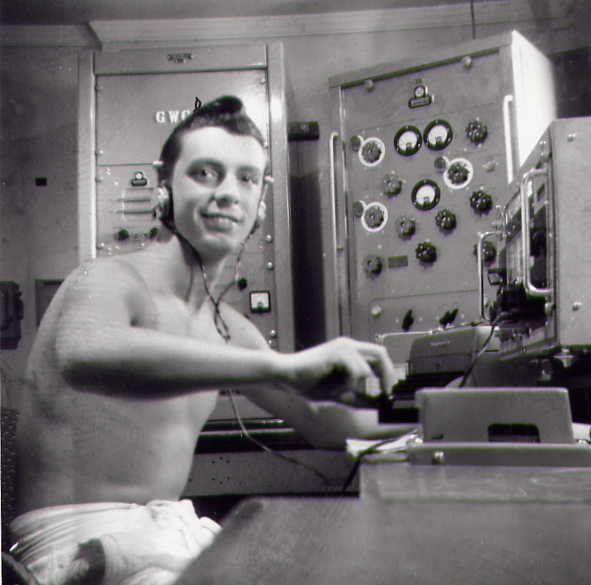
Terry Gardner transmits from somewhere in the Persian
Gulf while aboard Shell's ZAPHON/GWCD. Obviously in the 'rig of the day', akin to our current 'dress down Fridays' in civvy
street! Ex Marconi men will recognise the equipment and what's that - a typewriter!?
The GPO coast station at Portpatrick is shown below
(GPK/472 kc/s). Picture supplied by John Hastie who also worked at Wickradio/GKR. Picture taken 1951.
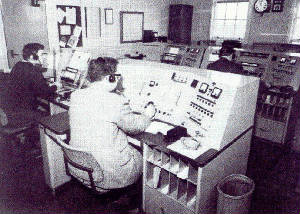
An interesting comparison below. The 'communications
office' aboard P & O's CANBERRA, provided by ex R/O Don Chapman, has itself passed into the history books
while the picture below this group is of the W/T office aboard the EMPRESS OF BRITAIN circa 1930s. Nowadays, with
satellite communications the norm and the 'extinction' of the radio officer the last century was, indeed, revolutionary
with respect to communications.
|
|
| CANBERRA-R/T ROOM Courtesy Don Chapman |
|
|
| CANBERRA R/T ROOM Courtesy Don Chapman |
|
|
| CANBERRA SRE ROOM Courtesy Don Chapman |
|
|
| CANBERRA W/T OFFICE Courtesy Don Chapman |
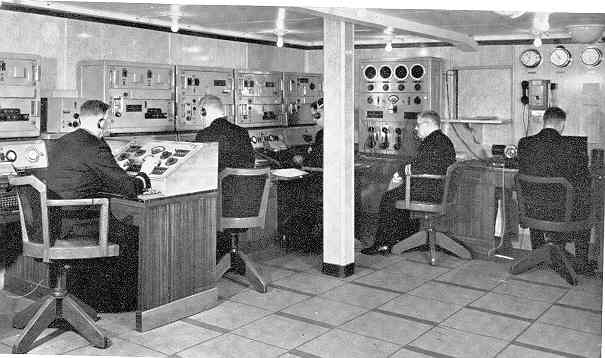
The radio receiving and control room aboard QUEEN
ELIZABETH/GBSS.
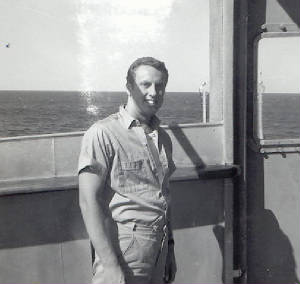
The author aboard SUNWALKER/5LQO on 'port bridge
wing lookout' somewhere in the Bermuda Triangle between Port Alfred, Quebec and Port of Spain. No B.S. on this ship. Just
one pleasant day after another. 8 hours of watchkeeping, no fussy chief R/O, reasonable food, cheap ciggies and gin along
with good company and a reasonable skipper.
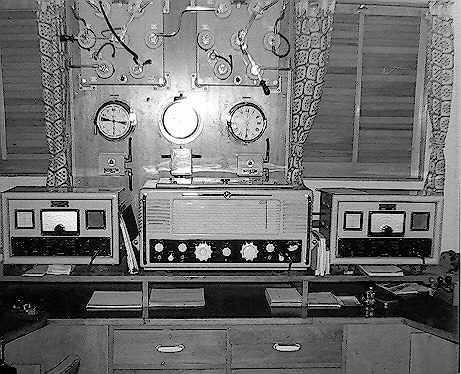
The main receiver and two emergency
receivers are shown here aboard CARINTHIA. These beautiful receivers were manufactured by Eddystone and were extremely rugged
units. One problem with the older tube type sets, of course, was frequency drift. Once operating temperatures had been reached,
however, they were very stable. Sensitivity, signal to noise ratios and bandspread were equivalent to the Marconi Atlanta
of the same period. The fact that the Eddystone would require two hands to change bands was immaterial!
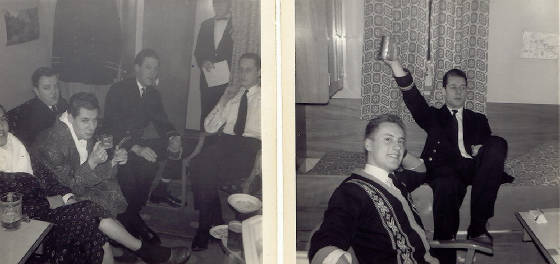
'Happy hour' above, aboard CARINTHIA.
Pursers get 'oiled up' in preparation for another evening of smiling faces and passenger entertainment. The author's cabin
(3rd R/O) barely provided seating for 'the gang'. The mates, 'ginger beers' and 'leckies' were located at some distance from
the purser's and R/O's accommodation. Phil, with stein in the air was the resident 'lady killer'. 'Romeo' was offered a job
at one point as a manager of a plantation outside New Orleans by one of his 'conquests'.
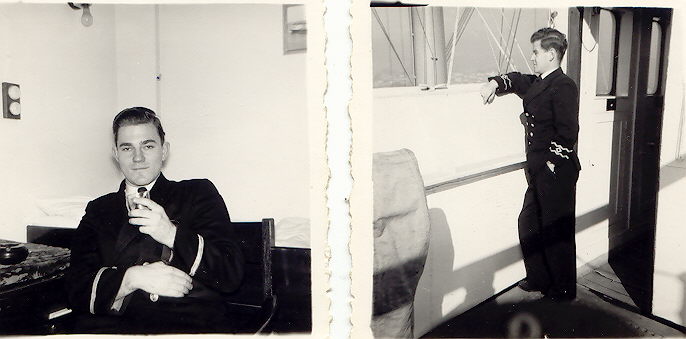
Two fine gentlemen aboard Anchor Line's
EUCADIA. On the left, Steve Bryant, 3rd mate. This was Steve's last trip before joining Burmah Shell. We visited Steve aboard
the BURMAH SAPHIRE in Karachi a while later. He was happy making an attractive salary above BOT rates but bored with the run
between the Persian Gulf and Karachi.
Angus McPhail (right) chief R/O from Dunoon had opted to stay with Anchor Line and
specifically EUCADIA for some time.
|
|
| Angus (Gus) McPhail aboard EUCADIA 1959 |
The author aboard STIRLING CASTLE/GYPX
at the CW position working GKL or ZSL. If Portisheadradio then probably on one of our QTC 12 days when told QRY15 or some
such number especially if around Christmas with Interflora a major recipient. In the background is the Oceanspan coupled to
the Worldspan along with the Mercury & Electra receivers. HF SSB 'phone traffic was handled in a separate 'cubicle' in
the office. This was my last trip before returning to school for the MOT Radar 'ticket' thence to Canada and, for a while,
Saguenay Terminals SUNWALKER/5LQO.
The world map illustrates the convenience
available to ships at sea throughout the world for communicating on H.F. particularly when propagation was problematic.
DETAILS
ON THE APPLICATION OF THIS LONG DISTANCE AREA SCHEME AND THE TYPICAL WORKINGS OF A SHIP RADIO STATION ARE SHOWN IN A LINK
AT THE END OF THIS PAGE.
Towards the end, as the radio officer approached 'extinction' this facility was abandoned
and operators were compelled to communicate directly with the country of destination. This was not always an easy proposition
when faced with fluctuations in the 11 year sun spot cycle and 'dips' in propagation.
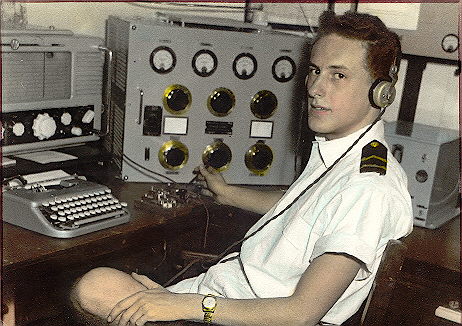
Left, the author aboard EUCADIA/GJZL. The IMRC
main receiver is seen on the left. The antiquated HF transmitter is also seen in the background. Tuning this unit for HF transmission
was a long drawn out affair involving the successive tuning of each stage from oscillator to PA. The emergency receiver over
my right shoulder was fixed tuned to 500 kc/s and may have predated Titanic!
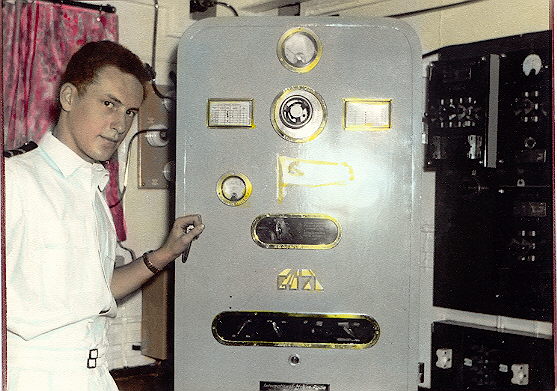
The MF transmitter is seen of forties vintage.
The front panel was opened in the manner of a car door. It was relatively easy to recognize an IMRC 'station' aboard other
ships from a unique 'rising' CW tone on medium frequencies. Even the 'QUEENS' had a distinctive note that never seemed 'becoming'
of such majestic liners! Typical IMR transmitters of the time were the IMR51/53 and IMR 81/83.
Here the steward puts me 'on the shake' on CARINTHIA.
My turn to buy the beer (you thought it was ALL mine?)
Time to 'turn to' and prepare for the invasion of the pursers.
Then an amazing dinner followed by the 8 to 12.
What great fun it was clearing faults on the old
"Span" at college! Our instructor, Bobby Corcoran, rest his soul, was hell bent on getting one over on us. His favourite was
a wee piece of Scotch tape across a couple of Z contacts at the rear. This picture provided by Malcolm McLeman of Blue Funnel
taken aboard ADRASTUS. (See Blue Funnel).
A typical discharge certificate from the Liberian
registered SUNWALKER/5LQO. Saguenay Terminals vessels were registered in a variety of countries, a selection of their ships
is given on the page SAGUENAY TERMINALS along with a history of this fine company, now extinct.
These two lists above should bring
back some memories for operators. With your current high tech digitally synthesized receivers don't expect to hear any of
these call signs today!
ABOARD P & O's CANBERRA
The pictures below are courtesy of
William Potter, an ex. Electronics Officer with P & O.
The W/T room was fairly standard for the time with a window
through to the R/T room next door. The radio office aboard CANBERRA was actually designed by the radio staff. Tape recorders
could pick off any incoming signals from any Rx. and the area was wired such that 'phones could be plugged in at many of the
jacks in the room. The output from any particular receiver would be selected by rotary switch. The main receiver was the Marconi
Atlanta. A selection of directional aerials was also available.
The R/T room contained Racal synthesised receivers.
R/T could also be used for SSB. Adjacent this room were two 'phone booths although signals could be connected to state rooms
via the manual/automatic telephone exchanges aboard.
The CINEMA is also shown, the operation of which was carried
out by other crew members although the Electronics Dept. was responsable for this on-board facility.
The PROJECTION
RADAR is also shown here. The 1st. R/O, Jim Meaney, is shown examining the 1 inch. CRT with true motion beamed onto a 16mm.
film camera which took pictures at 1 second intervals. The film was chemically processed in 'real time' then projected with
a Xenon light source onto a ground glass screen over which was drawn a sheet of paper from a roll on the side. This meant
that the navigators could draw plots using standard drawing instruments either to keep for the record 'if they hit something'
or to tear up and discard.
There were also a couple of Kelvin Hugh's radar units on either side of the bridge, as
well as the echo sounder.
For an explanation of the LONG DISTANCE AREA SCHEME and the day to day workings of a typical ship station please click here
and select RADIOGRAMS.
The following two pictures were kindly
provided by Captain George A Grekos. George was Radio Officer from 1966 until 1975, bridge mate from 1975 until 1989 and finally
Captain and Senior Port Captain from 1989 until 1995.
|
|
| AEGIS ATHENIC/SXPT - Courtesy Captain George A. Grekos. |
Above, the radio room of the AEGIS
ATHENIC, built 1973 and demolished in Alang, India in 1995. Equipment seen is the SAIT MB 1600B consul H.F. transmitter 1500W,
M.F. 400W.
Main receiver the British Eddystone and emergency receiver a Drake SP44 (the famous ham model!).
|
|
| AEGIS STORM/SVKR - Courtesy Captain George A. Grekos |
The radio office of the AEGIS STORM
built in 1962 and demolished in Pakistan in 1987.
Equipment comprised the ITT Mackay H.F. transmitter 1500W and M.F. 500W.
Both main & emergency receivers were Redifon.
Radio
Office, RMS Queen Elizabeth, 1964
Brian
Staton, Dave Nester, Jat Wooldridge, Dave Tunnicliffe
Brian
Jeffreys, Adrian (Bing) Crosby, Tony Johnston, Willie Powell
|
|
| RADIO OFFICE S.S. 'UNITED STATES'/KJEH - Courtesy Richard Rabbett |
PLEASE SCROLL TO THE TOP FOR A FURTHER SELECTION
|

